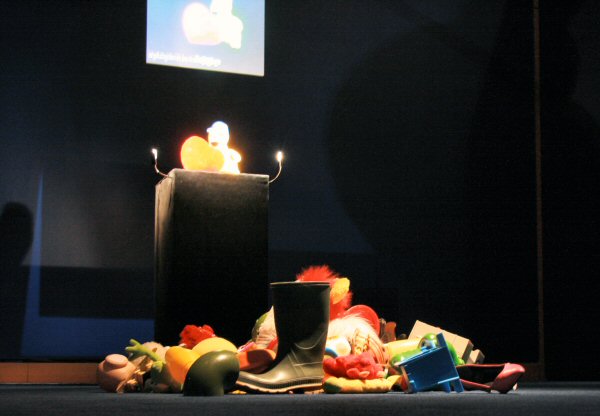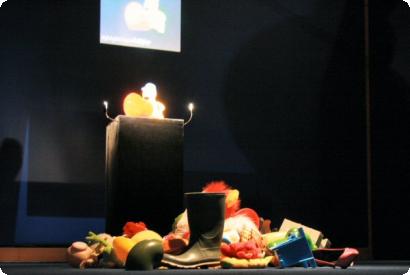Please wait a few moments while we process your request

David Rokeby, The Giver of Names (1991-)
Documentary Collection
Introduction to the Collection, by Caitlin Jones and Lizzie Muller
Background
Documentation serves a multitude of functions. Art historians look for contextual information to enrich their understanding of their subjects, and art conservators have long documented the inevitable natural and man-made changes that occur in works of art over time. Whether it is a time-based digital media work or an oil painting these changes can often tell us much about the material nature of the work as well as something of the artist’s intent. With media art there is not one, static, unique object, but often a collection of components, hardware and software which together create a time and process based experience. With works changing at a rate much faster than traditional media due to technological obsolescence, the need for comprehensive documentation becomes of utmost importance. As such, historical research documentation serves an increasingly vital function.
Unfortunately, a lack of documentation has lead to a situation in which we know far too little about many of the landmark works of new media art. Traditional models of documentation have left some gaps in the record, the largest of which is the documentation of the audience, both their views and impressions about a work within a specific context and also, when applicable, how they interacted with it. This collection of documentation on the artwork The Giver of Names, by David Rokeby, is a case-study which demonstrates how such gaps in the documentary record may be filled. In late 2007 the authors were awarded research residencies at the Daniel Langlois Foundation Centre for Research and Documentation (CR+D) to explore ways of documenting digital media artworks. Our research projects focused on the exhibition e-art, New Technologies and Contemporary Art curated by Jean Gagnon at the Montreal Museum of Fine Arts. Caitlin Jones' research objective was to examine a number of existing models of documentation with an emphasis on artist's intent. Lizzie Muller's original research objective was to find ways to document and archive the audience's descriptions of their experiences. We chose to conduct a joint documentary case-study to develop and demonstrate the integration of our two objectives, and this collection is the result.
We were delighted to have the opportunity to create a collection for The Giver of Names. Rokeby is an artist who has reflected and written extensively about his work, including his iterative production methods and the role of audience experience. He is highly articulate and reflective about his process and intent. The Giver of Names is an interactive piece which requires considerable participation from the audience in order to be activated. It has a long, illustrious exhibition history and has evolved over many versions. Significantly, however, Rokeby suggests that the work has reached its ‘sweet spot,’ where few changes are envisaged in the future. This creates an excellent opportunity to review the work's history and create a full record of the installation at this moment in time.
Creating a documentary collection
The term 'archive' has come to hold a variety of meanings, but it often implies a totality of documentation, in some state of completion. The term 'documentation' has a much looser connotation and it is with this in mind that we want to take care to properly define our terms in this case study. To do this we decided to look to traditional archival principles. In the field of archival science (within Canada) the fonds is the highest level of archival description, which according to the Canadian Council of Archives, is "the whole of the documents, regardless of form or medium, automatically and organically created and/or accumulated and used by a particular individual, family, or corporate body in the course of that creator's activities or functions" (from the Canadian Council of Archive’s "Rules for Archival Description"). Distinguishable from this, a collection is described as "an artificial accumulation of documents of any provenance brought together on the basis of some common characteristic, e.g., way of acquisition, subject, language, medium, type of document, name of collector, which may be treated for descriptive purposes as a unit under a common title." The key difference, as it relates to our research, is the notion of 'automatically and organically created' vis a vis 'artificial accumulation.' Our case study, which we would perhaps hesitate to refer to as 'artificial,' is most certainly a collection of information entirely solicited by us as researchers, based on our particular research goals. In this sense we have actively amassed a 'collection' of carefully curated documentation. In our view this active role is necessary, but also requires a degree of self-reflexivity and openness in terms of how the collection was formed. As such, for this Documentary Collection we describe the materials we have collected and also the rationale and motivations behind our decisions of what to include.
Documentation serves a multitude of functions. Art historians look for contextual information to enrich their understanding of their subjects, and art conservators have long documented the inevitable natural and man-made changes that occur in works of art over time. Whether it is a time-based digital media work or an oil painting these changes can often tell us much about the material nature of the work as well as something of the artist’s intent. With media art there is not one, static, unique object, but often a collection of components, hardware and software which together create a time and process based experience. With works changing at a rate much faster than traditional media due to technological obsolescence, the need for comprehensive documentation becomes of utmost importance. As such, historical research documentation serves an increasingly vital function.
Unfortunately, a lack of documentation has lead to a situation in which we know far too little about many of the landmark works of new media art. Traditional models of documentation have left some gaps in the record, the largest of which is the documentation of the audience, both their views and impressions about a work within a specific context and also, when applicable, how they interacted with it. This collection of documentation on the artwork The Giver of Names, by David Rokeby, is a case-study which demonstrates how such gaps in the documentary record may be filled. In late 2007 the authors were awarded research residencies at the Daniel Langlois Foundation Centre for Research and Documentation (CR+D) to explore ways of documenting digital media artworks. Our research projects focused on the exhibition e-art, New Technologies and Contemporary Art curated by Jean Gagnon at the Montreal Museum of Fine Arts. Caitlin Jones' research objective was to examine a number of existing models of documentation with an emphasis on artist's intent. Lizzie Muller's original research objective was to find ways to document and archive the audience's descriptions of their experiences. We chose to conduct a joint documentary case-study to develop and demonstrate the integration of our two objectives, and this collection is the result.
We were delighted to have the opportunity to create a collection for The Giver of Names. Rokeby is an artist who has reflected and written extensively about his work, including his iterative production methods and the role of audience experience. He is highly articulate and reflective about his process and intent. The Giver of Names is an interactive piece which requires considerable participation from the audience in order to be activated. It has a long, illustrious exhibition history and has evolved over many versions. Significantly, however, Rokeby suggests that the work has reached its ‘sweet spot,’ where few changes are envisaged in the future. This creates an excellent opportunity to review the work's history and create a full record of the installation at this moment in time.
Creating a documentary collection
The term 'archive' has come to hold a variety of meanings, but it often implies a totality of documentation, in some state of completion. The term 'documentation' has a much looser connotation and it is with this in mind that we want to take care to properly define our terms in this case study. To do this we decided to look to traditional archival principles. In the field of archival science (within Canada) the fonds is the highest level of archival description, which according to the Canadian Council of Archives, is "the whole of the documents, regardless of form or medium, automatically and organically created and/or accumulated and used by a particular individual, family, or corporate body in the course of that creator's activities or functions" (from the Canadian Council of Archive’s "Rules for Archival Description"). Distinguishable from this, a collection is described as "an artificial accumulation of documents of any provenance brought together on the basis of some common characteristic, e.g., way of acquisition, subject, language, medium, type of document, name of collector, which may be treated for descriptive purposes as a unit under a common title." The key difference, as it relates to our research, is the notion of 'automatically and organically created' vis a vis 'artificial accumulation.' Our case study, which we would perhaps hesitate to refer to as 'artificial,' is most certainly a collection of information entirely solicited by us as researchers, based on our particular research goals. In this sense we have actively amassed a 'collection' of carefully curated documentation. In our view this active role is necessary, but also requires a degree of self-reflexivity and openness in terms of how the collection was formed. As such, for this Documentary Collection we describe the materials we have collected and also the rationale and motivations behind our decisions of what to include.
Caitlin Jones & Lizzie Muller © 2008 FDL
This essay is also available as a printer friendly PDF file:
https://www.fondation-langlois.org/pdf/e/documentary-collection.pdf
Index:
- Introduction to the Collection
• Background
• Between real and ideal
• Our process
• Conclusion - The Giver of Names: Documentary Collection
• Interview with David Rokeby
• Installation views
• Technical details and hardware
- Drawings
- Hardware
• Exhibition context
• Audience interviews
- Video-cued recalls
- Semi-structured interviews
- Exit interviews
- Museum attendants interviews
• Other installations
• Links and Resources
Related pages:
 Lizzie Muller, Towards an oral history of new media art
Lizzie Muller, Towards an oral history of new media artNew media art presents a challenge to existing documentary and archival practices.
 Caitlin Jones, Surveying the state of the art (of documentation)
Caitlin Jones, Surveying the state of the art (of documentation)History is composed of documents because the document is what remains.
 David Rokeby
David RokebyDavid Rokeby is an interactive sound and video installation artist based in Toronto, Canada.



